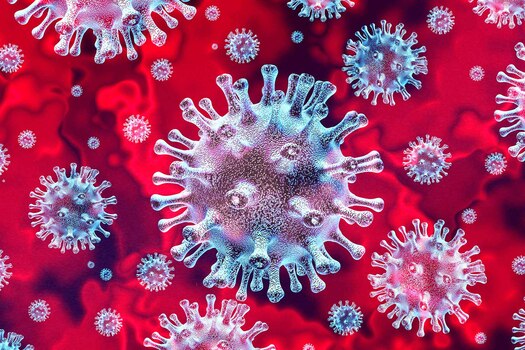NEW DELHI, Apr 16: There is consistent, strong evidence to prove that the SARS-CoV-2 virus, behind the COVID-19 pandemic, is predominantly transmitted through the air, according to a new assessment published on Friday in medical journal The Lancet found. It claimed of “consistent, strong evidence” to justify the conclusion that the SARS-CoV-2 virus, which causes COVID-19, is predominantly transmitted through the air.
“Once we acknowledge this virus is airborne, we know how to fix it. There are many examples of places that have fared much better by acknowledging this virus is airborne from the start. The world needs to follow their lead as soon as possible,” the researchers said.
The public health measures that fail to treat the virus as predominantly airborne leave people unprotected and allow the virus to spread, according to six experts from the UK, USA and Canada, including Jose-Luis Jimenez, a chemist at the Cooperative Institute for Research in Environmental Sciences (CIRES) and the University of Colorado Boulder.
Although some studies in the past have suggested that COVID-19 may spread through air, overall scientific literature on the subject has been inconclusive.
In July last year, over 200 scientists from 32 nations wrote to the WHO, saying there is evidence that the coronavirus is airborne, and even smaller particles can infect people.
“The evidence supporting airborne transmission is overwhelming, and evidence supporting large droplet transmission is almost non-existent,” Jimenez said. “It is urgent that the World Health Organization and other public health agencies adapt their description of transmission to the scientific evidence so that the focus of mitigation is put on reducing airborne transmission.”
The team of experts published research and identified 10 lines of evidence to support the predominance of the airborne route.
At the top of their list: Super-spreader events such as the Skagit Choir outbreak, in which 53 people became infected from a single infected case. Studies have confirmed these events cannot be adequately explained by close contact or touching shared surfaces or objects.
The researchers noted that the transmission rates of SARS-CoV-2 are much higher indoors than outdoors, and transmission is greatly reduced by indoor ventilation.
The team highlighted research estimating that silent (asymptomatic or presymptomatic) transmission of SARS-CoV-2 from people who are not coughing or sneezing accounts for at least 40 per cent of all transmission. This silent transmission is a key way COVID-19 has spread around the world, “supporting a predominantly airborne mode of transmission,” according to the assessment. The researchers also cited work demonstrating long-range transmission of the virus between people in adjacent rooms in hotels; people who were never in each other’s presence.
By contrast, the team found little to no evidence that the virus spreads easily via large droplets, which fall quickly through the air and contaminate surfaces.
“We were able to identify and interpret highly complex and specialist papers on the dynamics of fluid flows and the isolation of live virus,” the researchers said. “While some individual papers were assessed as weak, overall the evidence base for airborne transmission is extensive and robust. There should be no further delay in implementing measures around the world to protect against such transmission.”
The new work has serious implications for public health measures designed to mitigate the pandemic. First, “droplet measures” such as hand-washing and surface cleaning, while not unimportant, should be given less emphasis than airborne measures, which deal with inhalation of infectious particles suspended in the air.
If an infectious virus is primarily airborne, someone can potentially be infected when they inhale aerosols produced when an infected person exhales, speaks, shouts, sings, or sneezes. So airborne control measures include ventilation, air filtration, reducing crowding and the amount of time people spend indoors, wearing masks whenever indoors (even if not within 6 feet or 2 meters of others), attention to mask quality and fit, and higher-grade PPE for healthcare and other staff when working in contact with potentially infectious people.
“It is quite surprising that anyone is still questioning whether the airborne transmission is the predominant transmission pathway for this virus or not,” said co-author Professor Kimberly Prather, an aerosol scientist from the University of California San Diego. “Only by including inhalation of aerosols at both close and long range can we explain the many indoor outbreaks that have occurred around the globe. Once we acknowledge this virus is airborne, we know how to fix it. There are many examples of places that have fared much better by acknowledging this virus is airborne from the start. The world needs to follow their lead as soon as possible.”
(Manas Dasgupta)

